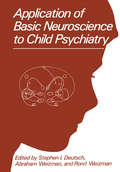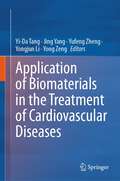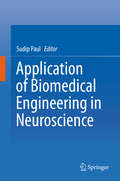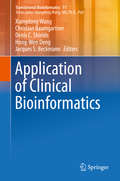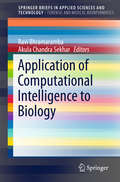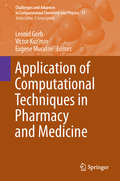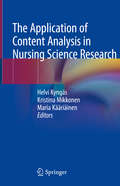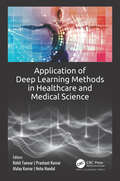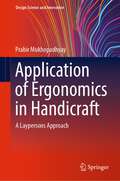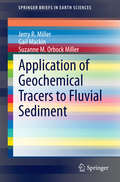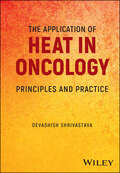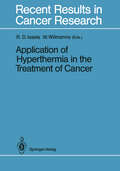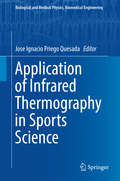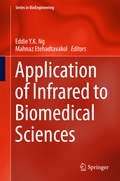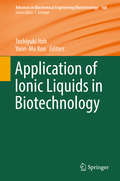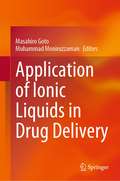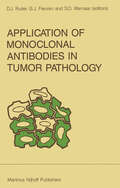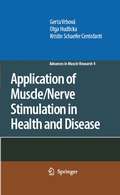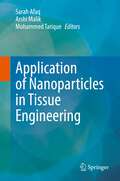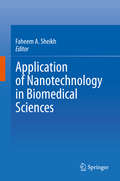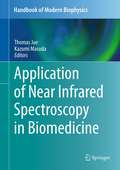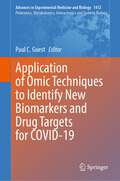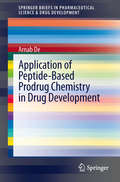- Table View
- List View
Application of Basic Neuroscience to Child Psychiatry
by Stephen I. Deutsch, Abraham Weizman and Ronit WeizmanThe idea for this book developed during the course of several discussions among the editors while we were working together as staff scientists in the laboratories of the Clinical Neuro science Branch of the National Institute of Mental Health. It was a happy coincidence that the three of us, child psychiatrists with predominantly clinical interests, selected a collaborative bench research project involving neurotransmitter receptor characterization and regulation. We appreciated the relevance of our work to child psychiatry and wished for a forum to share the excitement we enjoyed in the laboratory with our clinical colleagues. Moreover, it seemed to us that much of the pharmacological research in child psychiatry proceeded on an empirical basis, often without a compelling neurochemical rationale. This could reflect the paucity of neurochemical data that exists in child psychiatry and the very limited understanding of the pathophysiology in most psychiatric disorders that occur in childhood. Also, we bemoaned the fact that there was a virtual absence of meaningful interchange between clinical investigators in child psychiatry and their colleagues in the neurosciences. We believed that an edited book appealing to clinicians and basic scientists could serve as an initial effort to foster interchange between them. The editors wish to emphasize that this book is viewed as only a beginning in the process of interchange that must take place.
Application of Biomaterials in the Treatment of Cardiovascular Diseases
by Yi-Da Tang Jing Yang Yufeng Zheng Yongjun Li Yong ZengThis book summarizes the recent advancements for biomaterials in the field of cardiovascular disease, including drug delivery system (gene, protein, drug), implant interventional instrument (heart valve, heart blocker, stent, artificial blood vessel, patch, artificial heart, cardiac pacemaker, etc.) have been innovated and applied to the clinical uses to treatment of cardiovascular disease. Through the summary of this book, readers will have comprehensive and advanced understanding of the application of biomaterials in the field of cardiovascular disease.
Application of Biomedical Engineering in Neuroscience
by Sudip PaulThis book focuses on interdisciplinary research in the field of biomedical engineering and neuroscience. Biomedical engineering is a vast field, ranging from bioengineering to brain-computer interfaces. The book explores the system-level function and dysfunction of the nervous system from scientific and engineering perspectives. The initial sections introduce readers to the physiology of the brain, and to the biomedical tools needed for diagnostics and effective therapies for various neurodegenerative and regenerative disorders. In turn, the book summarizes the biomedical interventions that are used to understand the neural mechanisms underlying empathy disorders, and reviews recent advances in biomedical engineering for rehabilitation in connection with neurodevelopmental disorders and brain injuries. Lastly, the book discusses innovations in machine learning and artificial intelligence for computer-aided disease diagnosis and treatment, as well as applications of nanotechnology in therapeutic neurology.
Application of Clinical Bioinformatics (Translational Bioinformatics #11)
by Xiangdong Wang Christian Baumgartner Denis C. Shields Hong-Wen Deng Jacques S. BeckmannThis book elucidates how genetic, biological and medical information can be applied to the development of personalized healthcare, medication and therapies. Focusing on aspects of the development of evidence-based approaches in bioinformatics and computational medicine, including data integration, methodologies, tools and models for clinical and translational medicine, it offers an essential introduction to clinical bioinformatics for clinical researchers and physicians, medical students and teachers, and scientists working with human disease-based omics and bioinformatics. Dr. Xiangdong Wang is a distinguished Professor of Medicine. He is Director of Shanghai Institute of Clinical Bioinformatics, Director of Fudan University Center for Clinical Bioinformatics, Deputy Director of Shanghai Respiratory Research Institute, Director of Biomedical Research Center, Fudan University Zhongshan Hospital, Shanghai, China; Dr. Christian Baumgartner is a Professor of Health Care and Biomedical Engineering at Institute of Health Care Engineering with European Notified Body of Medical Devices, Graz University of Technology, Graz, Austria; Dr. Denis Shields is a Professor of Clinical Bioinformatics at Conway Institute, Belfield, Dublin, Ireland; Dr. Hong-Wen Deng is a Professor at Department of Biostatistics and Bioinformatics, Tulane University School of Public Health and Tropical Medicine, USA; Dr. Jacques S Beckmann is a Professor and Director of Section of Clinical Bioinformatics, Swiss Institute of Bioinformatics, Switzerland.
Application of Computational Intelligence to Biology (SpringerBriefs in Applied Sciences and Technology)
by Ravi Bhramaramba Akula Chandra SekharThis book is a contribution of translational and allied research to the proceedings of the International Conference on Computational Intelligence and Soft Computing. It explains how various computational intelligence techniques can be applied to investigate various biological problems. It is a good read for Research Scholars, Engineers, Medical Doctors and Bioinformatics researchers.
Application of Computational Techniques in Pharmacy and Medicine (Challenges and Advances in Computational Chemistry and Physics #17)
by Leonid Gorb Victor Kuz’min Eugene MuratovThe proposed volume provides both fundamental and detailed information about the computational and computational-experimental studies which improve our knowledge of how leaving matter functions, the different properties of drugs (including the calculation and the design of new ones), and the creation of completely new ways of treating numerical diseases. Whenever it is possible, the interplay between theory and experiment is provided. The book features computational techniques such as quantum-chemical and molecular dynamic approaches and quantitative structure–activity relationships.The initial chapters describe the state-of-the art research on the computational investigations in molecular biology, molecular pharmacy, and molecular medicine performed with the use of pure quantum-chemical techniques. The central part of the book illustrates the status of computational techniques that utilize hybrid, so called QM/MM approximations as well as the results of the QSAR studies which now are the most popular in predicting drugs’ efficiency. The last chapters describe combined computational and experimental investigations.
The Application of Content Analysis in Nursing Science Research
by Helvi Kyngäs Kristina Mikkonen Maria KääriäinenThis book provides principles on content analysis and its application into development of nursing theory. It offers clear guidance to students, lecturers and researchers to gain a deeper understanding of the method of content analysis, its implementation into their own research and criteria of trustworthiness evaluation. The book is written in user-friendly language with provided research examples and cases, and the content is illustrated by figures and tables. The authors offer their expertise in providing a well thought through explanation of content analysis in didactical style, which will enhance university education. The book includes highly experienced researchers who have published articles on content analysis and the trustworthiness of the method with more than 10 000 citations. Divided into two parts, this book explores the application of content analysis into nursing science. The first part presents the philosophical position of content analysis, inductive and deductive methods of using content analysis, trustworthiness of the method, and ethical consideration of using content analysis. The second part informs on the theory development based on content analysis, conceptualization of the concepts of content analysis into generation of items and instrument development, and statistical testing of a hypothetical model. The last chapter shows a new approach to using content analysis in systematic reviews and quality evaluation of methodology within systematic review process. The book is an essential tool for nursing science, providing instruction on key methodological elements in order to provide rigorously conducted empirical research for clinical practice and nursing education.
Application of Deep Learning Methods in Healthcare and Medical Science
by Rohit Tanwar Prashant Kumar Malay Kumar Neha NandalThe volume provides a wealth of up-to-date information on developments and applications of deep learning in healthcare and medicine, providing deep insight and understanding of novel applications that address the tough questions of disease diagnosis, prevention, and immunization. The volume looks at applications of deep learning for major medical challenges such as cancer detection and identification, birth asphyxia among neonates, kidney abnormalities, white blood cell segmentation, diabetic retinopathy detection, and Covid-19 diagnosis, prevention, and immunization. The volume discusses applications of deep learning in detection, diagnosis, intensive examination and evaluation, genomic sequencing, convolutional neural networks for image recognition and processing, and more for health issues such as kidney problems, brain tumors, lung damage, and breast cancer. The authors look at ML for brain tumor segmentation, in lung CT scans, in digital X-ray devices, and for logistic and transport systems for effective delivery of healthcare.
Application of Deep Learning Methods in Healthcare and Medical Science
by Rohit Tanwar Prashant Kumar Malay Kumar Neha NandalThe volume provides a wealth of up-to-date information on developments and applications of deep learning in healthcare and medicine, providing deep insight and understanding of novel applications that address the tough questions of disease diagnosis, prevention, and immunization. The volume looks at applications of deep learning for major medical challenges such as cancer detection and identification, birth asphyxia among neonates, kidney abnormalities, white blood cell segmentation, diabetic retinopathy detection, and Covid-19 diagnosis, prevention, and immunization. The volume discusses applications of deep learning in detection, diagnosis, intensive examination and evaluation, genomic sequencing, convolutional neural networks for image recognition and processing, and more for health issues such as kidney problems, brain tumors, lung damage, and breast cancer. The authors look at ML for brain tumor segmentation, in lung CT scans, in digital X-ray devices, and for logistic and transport systems for effective delivery of healthcare.
Application of Ergonomics in Handicraft: A Laypersons Approach (Design Science and Innovation)
by Prabir MukhopadhyayThis book is about the application of ergonomics in handicraft manufacturing and design keeping in mind the two sets of users, craftsmen and customers buying handicraft items. Written in an easy to understand language and in a story telling format. It requires no prior knowledge of the subject nor any knowledge of science or technology for using this book and applying it in handicraft manufacturing and design. The book starts with an overview of the application of ergonomics in different aspects of craft manufacturing, touching upon tools, space, process and then moves into the aspects of ergonomics of craft packaging and displaying. Alongside the book also explains the ergonomic aspects of designing of handicraft products keeping the users of the products in mind, their dimensions, capacity, limitations etc. Each chapter starts with an "overview" and ends with "key points" and exercises to help the readers in applying the principles of ergonomics in handicraft. The last chapter is dedicated to exercises in different areas of handicraft and the ergonomic applications for them, followed by ergonomic design directions to solve them.
Application of Geochemical Tracers to Fluvial Sediment (SpringerBriefs in Earth Sciences)
by Jerry R. Miller Gail Mackin Suzanne M. Orbock MillerThis book takes an in-depth look at the theory and methods inherent in the tracing of riverine sediments. Examined tracers include multi-elemental concentration data, fallout radionuclides (e.g., 210Pb, 137Cs, 7Be), radiogenic isotopes (particularly those of Pb, Sr, and Nd), and novel (“non-traditional”) stable isotopes (e.g., Cd, Cu, Hg, and Zn), the latter of which owe their application to recent advances in analytical chemistry. The intended goal is not to replace more ‘traditional’ analyses of the riverine sediment system, but to show how tracer/fingerprinting studies can be used to gain insights into system functions that would not otherwise be possible. The text, then, provides researchers and catchment managers with a summary of the strengths and limitations of the examined techniques in terms of their temporal and spatial resolution, data requirements, and the uncertainties in the generated results. The use of environmental tracers has increased significantly during the past decade because it has become clear that documentation of sediment and sediment-associated contaminant provenance and dispersal is essential to mitigate their potentially harmful effects on aquatic ecosystems. Moreover, the use of monitoring programs to determine the source of sediments to a water body has proven to be a costly, labor intensive, long-term process with a spatial resolution that is limited by the number of monitoring sites that can be effectively maintained. Alternative approaches, including the identification and analysis of eroded upland areas and the use of distributed modeling routines also have proven problematic. The application of tracers within riverine environments has evolved such that they focus on sediments from two general sources: upland areas and specific, localized, anthropogenic point sources. Of particular importance to the former is the development of geochemical fingerprinting methods that quantify sediment provenance (and to a much lesser degree, sediment-associated contaminants) at the catchment scale. These methods have largely developed independently of the use of tracers to document the source and dispersal pathways of contaminated particles from point-sources of anthropogenic pollution at the reach- to river corridor-scale. Future studies are likely to begin merging the strengths of both approaches while relying on multiple tracer types to address management and regulatory issues, particularly within the context of the rapidly developing field of environmental forensics.
The Application of Heat in Oncology: Principles and Practice
by Devashish ShrivastavaTHE APPLICATION OF HEAT IN ONCOLOGY Understand the use of heat to destroy tumors with this comprehensive guide Heat is an indispensable resource in the destruction of cancerous tumors to potentially treat cancers. There are also real challenges, however, involved in the total destruction of tumors without destroying healthy tissue surrounding the tumor in the process. A detailed understanding of the propagation of thermal energy, induced heating, and tissue responses to heat is required to safely and successfully apply heat-based technologies in clinical oncology. The Application of Heat in Oncology supplies this understanding, with a thorough, comprehensive overview of the principle and practice involved. Offering both a detailed introduction to the physics and thermodynamics of induced heat and an analysis of its clinical applications, this is an essential resource for clinicians, technicians, and others in oncological practice. The Application of Heat in Oncology readers will also find: Guidelines for applying heat both safely and effectively Detailed discussion of topics including energy delivery (e.g., via RF, MW, ultrasound, laser, cryoagents, hyperthermia, nanoparticles, etc.), temperature assessment, damage assessment, image guidance, and more Summary of current practice along with suggestions for future areas of technological improvement The Application of Heat in Oncology is ideal for all clinicians working in the field of cancer treatment, including medical students, residents, researchers, engineers, radiologists, surgeons, and more.
The Application of Heat in Oncology: Principles and Practice
by Devashish ShrivastavaTHE APPLICATION OF HEAT IN ONCOLOGY Understand the use of heat to destroy tumors with this comprehensive guide Heat is an indispensable resource in the destruction of cancerous tumors to potentially treat cancers. There are also real challenges, however, involved in the total destruction of tumors without destroying healthy tissue surrounding the tumor in the process. A detailed understanding of the propagation of thermal energy, induced heating, and tissue responses to heat is required to safely and successfully apply heat-based technologies in clinical oncology. The Application of Heat in Oncology supplies this understanding, with a thorough, comprehensive overview of the principle and practice involved. Offering both a detailed introduction to the physics and thermodynamics of induced heat and an analysis of its clinical applications, this is an essential resource for clinicians, technicians, and others in oncological practice. The Application of Heat in Oncology readers will also find: Guidelines for applying heat both safely and effectively Detailed discussion of topics including energy delivery (e.g., via RF, MW, ultrasound, laser, cryoagents, hyperthermia, nanoparticles, etc.), temperature assessment, damage assessment, image guidance, and more Summary of current practice along with suggestions for future areas of technological improvement The Application of Heat in Oncology is ideal for all clinicians working in the field of cancer treatment, including medical students, residents, researchers, engineers, radiologists, surgeons, and more.
Application of Hyperthermia in the Treatment of Cancer (Recent Results in Cancer Research #107)
by WolfgangWilmanns Rolf D. IsselsPhysicians, biologists and physicists present their recent work in the field of hyperthermia with regard to both its application and its combination with radiation and chemotherapy. Current technical possibilities, clinical management and major aspects of its use for superficial and deep-seated tumors are pointed out. The main topics discussed are: changes of metabolism and microcirculation under heat conditions, the biological interaction of heat with X-rays and several chemotherapeutic agents, and the most recent clinical data from different institutions on the combined application in the treatment of cancer.
Application of Infrared Thermography in Sports Science (Biological and Medical Physics, Biomedical Engineering)
by Jose Ignacio Priego QuesadaThis book addresses the application of infrared thermography in sports, examining the main benefits of this non-invasive, non-radiating and low-cost technique. Aspects covered include the detection of injuries in sports medicine, the assessment of sports performance due to the existing link between physical fitness and thermoregulation and the analysis of heat transfer for sports garments and sports equipment. Although infrared thermography is broadly considered to be a fast and easy-to-use tool, the ability to deliver accurate and repeatable measurements is an important consideration. Furthermore, it is important to be familiar with the latest sports studies published on this technique to understand its potential and limitations. Accordingly, this book establishes a vital link between laboratory tests and the sports field.
Application of Infrared to Biomedical Sciences (Series in BioEngineering)
by Eddie Yk Ng Mahnaz EtehadtavakolThe book covers the latest updates in the application of infrared to biomedical sciences, a non-invasive, contactless, safe and easy approach imaging of skin and tissue temperatures. Its diagnostic procedure allows practitioners to identify the locations of abnormal chemical and blood vessel activity such as angiogenesis in body tissue. Its non-invasive approach works by applying the technology of the infrared camera and state-of-the-art software, where high-resolution digital infrared imaging technology benefits highly from enhanced image production, standardized image interpretation protocols, computerized comparison and storage, and sophisticated image enhancement and analysis. The book contains contributions from global prominent scientists in the area of infrared applications in biomedical studies. The target audience includes academics, practitioners, clinicians and students working in the area of infrared imaging in biomedicine.
Application of Ionic Liquids in Biotechnology (Advances in Biochemical Engineering/Biotechnology #168)
by Toshiyuki Itoh Yoon-Mo KooThis volume explores how ionic liquids are used in different areas of biotechnology. It also provides insights on the interaction of ionic liquids with biomolecules and biomaterials. Ionic liquids have become essential players in the fields of synthesis, catalysis, extraction and electrochemistry, and their unique properties have opened a wide range of applications in biotechnology. Readers will discover diverse examples of the application of ionic liquids as solvents for biomaterials extraction and pretreatment, in enzymatic and whole cell catalysed reaction, and as activation agents for biocatalysis. Particular attention is given to the biologically functionalized ionic liquids employed in medical and pharmaceutical applications. Although ionic liquids are considered “green solvents”, the contributing authors will also explore their environmental impact when applied to biotechnology. Chemical, biological and medical scientists interested in ionic liquids and biotechnology will find this work instructive and informative.
Application of Ionic Liquids in Drug Delivery
by Masahiro Goto Muhammad MoniruzzamanThis book presents recent advances in the use of ionic liquids in medicine and pharmaceutics with particular emphasis on addressing critical pharmaceutical challenges, including the low solubility, polymorphism, and bioavailability of drugs. It also provides insights into the development of the biologically functionalized ionic liquids suitable for medical and pharmaceutical applications. Ionic liquids have been used as potential solvents or materials in the fields of pharmaceutical drug delivery and formulations because of their unique and tunable physicochemical and biological properties. Readers find explanations of the diverse approaches to the application of ionic liquids in drug solubility, active pharmaceutical ingredient (API) formulation, and drug delivery systems, such as topical, transdermal, and oral delivery, with particular emphasis on recent developments. Particular attention is given to the development of ionic liquid-assisted effective drug delivery techniques for sparingly soluble or insoluble drug molecules. This book also discusses the biological activities of ionic liquids for possible applications in drug formulation and drug delivery systems. Scientists in disciplines such as chemistry, biology, and pharmaceutics find this book instructive and informative for developing ionic liquid-based drug formulations or drug delivery systems.
Application of Monoclonal Antibodies in Tumor Pathology (Developments in Oncology #50)
by Dirk J. Ruiter, Gert Jan Fleuren and Sven O. WarnaarThe development of monoclonal antibodies to human tumor associated antigens has greatly facilitated the application of immunohistochemical techniques to analyze surgically removed tissues. During the last few years this approach has been utilized by a progressively increasing number of investigators to analyze malignant cells. Although monoclonal antibodies to tumor associated antigens have not become yet routine reagents in immunopathology, they have provided new information which could not be obtained with conventional antisera or histochemical procedures. The following are representative examples. TUmor associated antigens have been identified which display a restricted distribution in normal tissues and therefore may represent useful markers for radio imaging and appropriate targets for immunotherapy. In spite of undetec table differences with conventional histopathological approaches hetero geneity has been found in the antigenic profile of tumor cells within a lesion, in autologous lesions removed from different anatomic sites from a given patient and in lesions removed from different patients. Phenotypes of tumor cells have been identified which correlate with the biology of tumor cells and with the clinical course of the disease. From a practical view point the use of monoclonal antibodies in immunopathology has enhanced interactions between pathologists and immunologists, as exemplified by the present book. Such interactions have contributed to the application of basic research to clinical problems. The chapter of this book discuss investigations performed with monoclonal antibodies to antigens expressed by various types of normal and malignant human cells.
Application of Muscle/Nerve Stimulation in Health and Disease (Advances in Muscle Research #4)
by Gerta Vrbová Olga Hudlicka Kristin Schaefer CentofantiThe first evidence that electrical changes can cause muscles to contract was p- vided by Galvani (1791). Galvani’s ideas about ‘animal electricity’ were explored during the 19th and 20th century when it was firmly established that ‘electricity’ is one of the most important mechanisms used for communication by the nervous system and muscle. These researches lead to the development of ever more soph- ticated equipment that could either record the electrical changes in nerves and muscles, or elicit functional changes by electrically stimulating these structures. It was indeed the combination of these two methods that elucidated many of the basic principles about the function of the nervous system. Following these exciting findings, it was discovered that electrical stimulation and the functions elicited by it also lead to long-term changes in the properties of nerves and particularly muscles. Recent findings help us to understand the mec- nisms by which activity induced by electrical stimulation can influence mature, fully differentiated cells, in particular muscles, blood vessels and nerves. Electrically elicited activity determines the properties of muscle fibres by activating a sequence of signalling pathways that change the gene expression of the muscle. Thus, elect- cal activity graduated from a simple mechanism that is used to elicit muscle c- traction, to a system that could induce permanent changes in muscles and modify most of its characteristic properties.
Application of Nanoparticles in Tissue Engineering
by Sarah Afaq Arshi Malik Mohammed TariqueThis book discusses advancements in the applications of nanoparticles in tissue engineering. It examines the applications of nanobiomaterials in hard tissue regeneration, fabrication, and characterization. The book also analyzes the implication of three-dimensional and four-dimensional fabrication techniques for the production of the scaffold in tissue engineering and their advantages over conventional scaffold production techniques. Further, it presents smart materials used in making 4-D scaffolds that imitate the dynamic response of tissue against natural stimuli and adapt to the microenvironment by changing their conformation or other properties. It also summarizes the growing field of biomolecular detection and biosensors in tissue engineering and the increasing prominence of nanoparticles in the biosensors. Further, it provides the future outlook and associated challenges of the application of nanomaterials in tissue engineering.
Application of Nanotechnology in Biomedical Sciences
by Faheem A. SheikhThis book highlights the wide applications of nanomaterials in healthcare and environmental remediation. Presenting nano-based materials that positively influence the growth and proliferation of cells present in soft and hard tissue and are used for the regeneration bone tissue and/or suppression of cancer cells, it also discusses the natural products that can be incorporated in nanofibers for the treatment of cancer. Further, it describes the use of blending and functionalization to produce chitosan nanofibers for biomedical applications, and reviews the role of plasma-enhanced gold nanoparticles in diagnostics and therapeutics. Lastly, the book also introduces various nanotechnology approaches for the removal of waste metabolites in drinking water, and explores the emerging applications of nanorobotics in medicine. Given its scope, this book is a valuable resource for scientists, clinicians, engineers and researchers aiming to gain a better understanding of the various applications of nanotechnology.
Application of Near Infrared Spectroscopy in Biomedicine (Handbook of Modern Biophysics)
by Thomas Jue and Kazumi MasudaIn keeping with the style of the Handbook of Modern Biophysics, this fourth volume, Application of Near-Infrared Spectroscopy in Biomedicine, balances the need for physical science/mathematics formalism with a demand for biomedical perspectives. Each chapter divides the presentation into two major parts: the first establishes the conceptual framework and describes the instrumentation or technique, while the second illustrates current applications in addressing complex biology questions. With the additional sections on further reading, problems, and references, the interested reader can explore some chapter ideas more widely.
Application of Omic Techniques to Identify New Biomarkers and Drug Targets for COVID-19 (Advances in Experimental Medicine and Biology #1412)
by Paul C. GuestThe COVID-19 pandemic caused by the SARS-CoV-2 virus has affected nearly every country and territory in the world. Although worldwide vaccination efforts have reduced the risk of serious disease outcomes, disparities in distribution have led to multiple waves of SARS-CoV-2 outbreaks and the emergence of variants of concern, some of which have enhanced infectivity and ability to evade existing vaccines. Hence there is an increasing interest in understanding the evolution of viruses like SARS-CoV-2, as well as improving our capacity to effectively current and manage future pandemics.This new volume reviews the most effective omic techniques for increasing our understanding of COVID-19, to improve diagnostics, prognostics, and genomic surveillance, and to facilitate development of effective treatments and vaccines. Chapters are written by an international team of experts and explore methods in the areas of genomics, transcriptomics, proteomics, and metabolomics. Techniques used to assess physiological function at the molecular level and artificial intelligence approaches used for more effective validation and translation of biomarker candidates into clinical use are also discussed. This book is an excellent resource for researchers studying biomarkers, virology, metabolic diseases, and infectious diseases, as well as clinical scientists, physicians, drug company scientists, and healthcare workers.
Application of Peptide-Based Prodrug Chemistry in Drug Development (SpringerBriefs in Pharmaceutical Science & Drug Development)
by Arnab DeMacromolecular (specifically peptide-based) drugs could potentially be highly effective medicines. However they have a relatively short duration of action and variable therapeutic index. An example of such a peptide is Glucagon-like Peptide I which could potentially be used as a revolutionary drug for diabetes. This is because it stimulates insulin only when the blood glucose level is high thereby reducing the risk of hypoglycemia (a significant disadvantage of using insulin is that an insulin overdose is the single most potent cause of life-threatening hypoglycemia). However it’s short duration of action (half-life of 2 minutes in plasma) precludes its therapeutic use. In this volume, the use of novel therapeutics like GLP1 as an alternative to tradition insulin-based drugs in diabetes is described. Application of Peptide-Based Prodrug Chemistry in Drug Development elucidates the traditional concept of prodrugs as “specialized non-toxic protective groups used in a transient manner to alter or to eliminate certain limiting properties in the parent small molecule” (IUPAC definition). It goes on to provide insight into how prodrugs of peptides (with GLP1 as an example) could be appropriately used to extend the biological half life, broaden the therapeutic index of macromolecules and improve the pharmacodynamics of such drugs. Author explains the logic behind designing peptide prodrugs, synthetic procedures and bioassays to examine the conversion of the prodrug to the drug under therapeutic conditions. The prodrugs described slowly convert to the parent drug at physiological conditions of 37C and pH 7.2 driven by their inherent chemical instability without the need of any enzymatic cleavage. The diketopiperazine and diketomorpholine (DKP and DMP) strategies for prodrug conversion are demonstrated in detail with special emphasis on the chemical flexibility that it offers to develop prodrugs with variable time actions.This book will be of useful to chemists, biochemists, medicinal chemists, biologists and people in the medical profession (doctors). It may be used in undergraduate classes but will certainly help post-graduate students and advanced professionals. The author is grateful to Prof. Richard DiMarchi (Standiford H. Cox Professor of Chemistry and the Linda & Jack Gill Chair in Biomolecular Sciences at Indiana University) for valuable suggestions. The foreword for the book has been written by Prof. Jean Martinez, (Legion d'Honneur awarded by the French Republic; Professor of Chemistry and Medicinal Chemistry of the University of Montpellier, France; and Chairman of European Peptide Society, 2002-2010).
